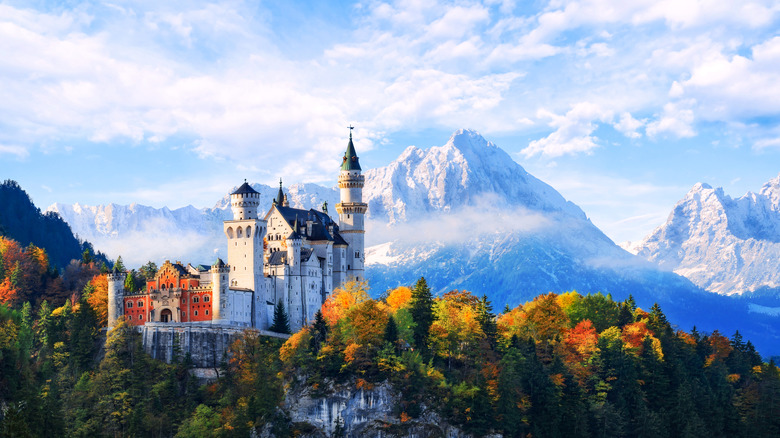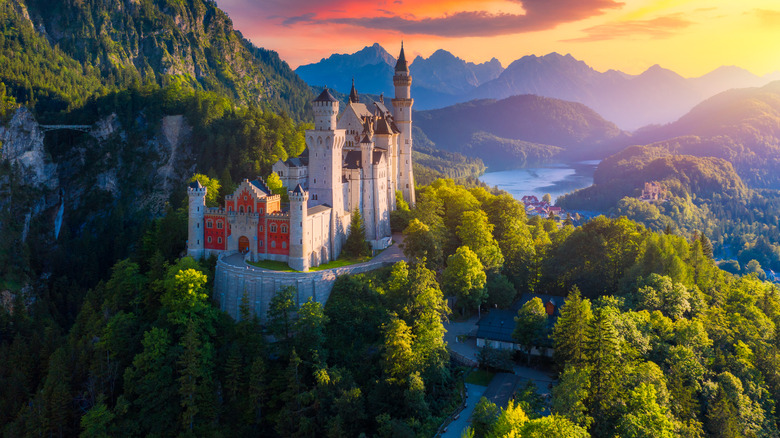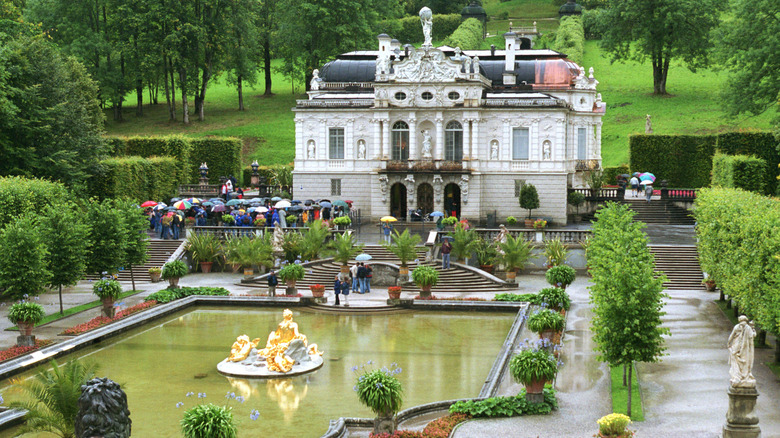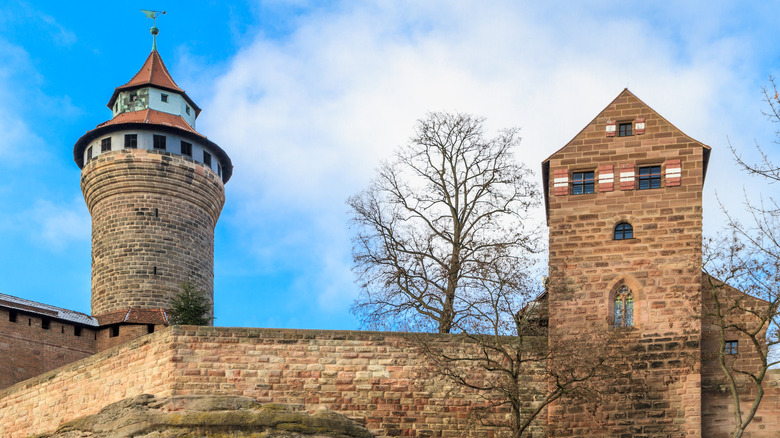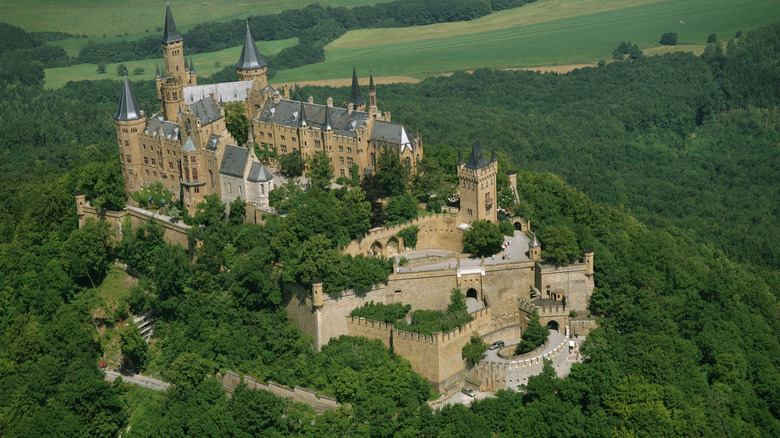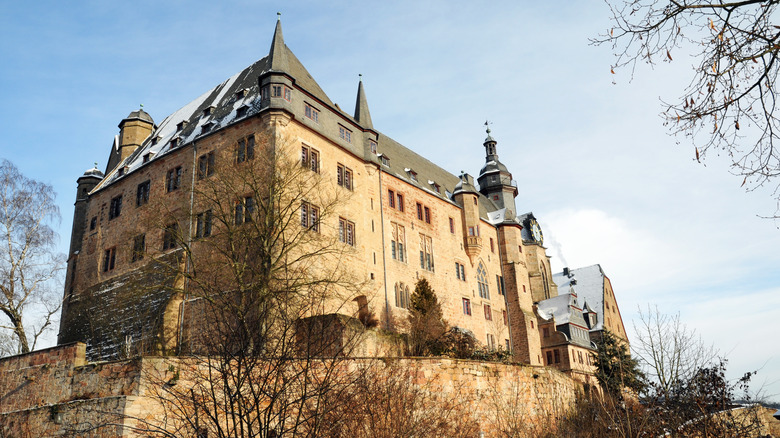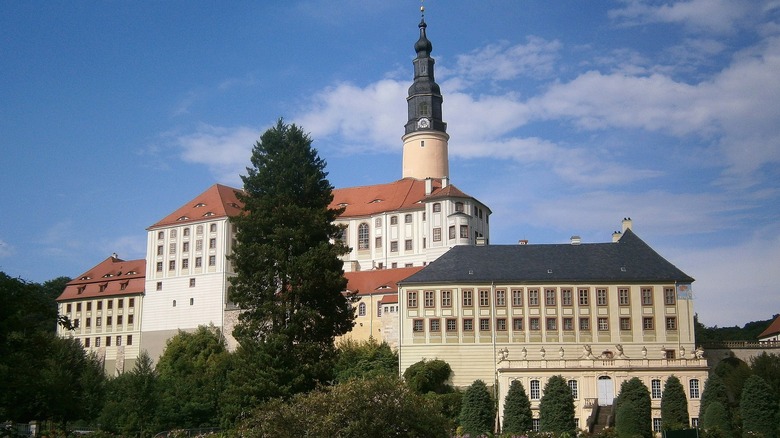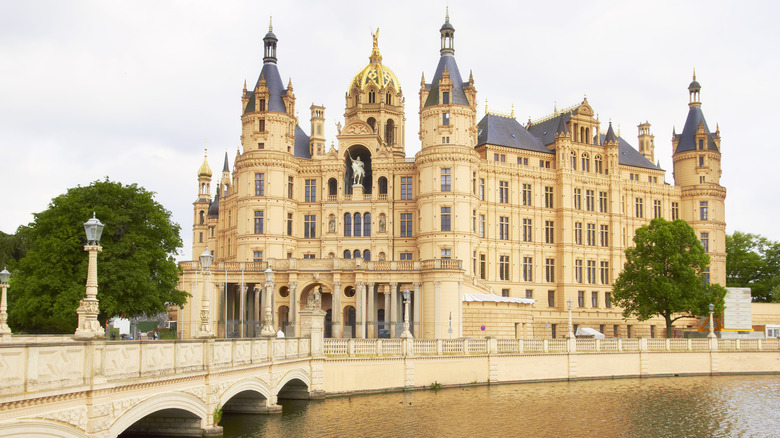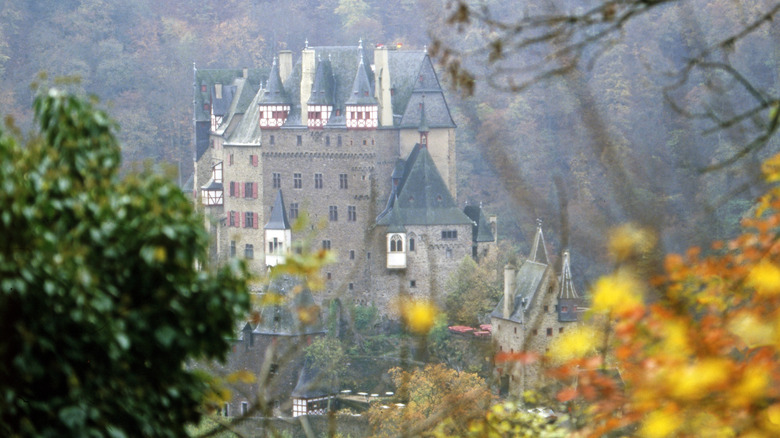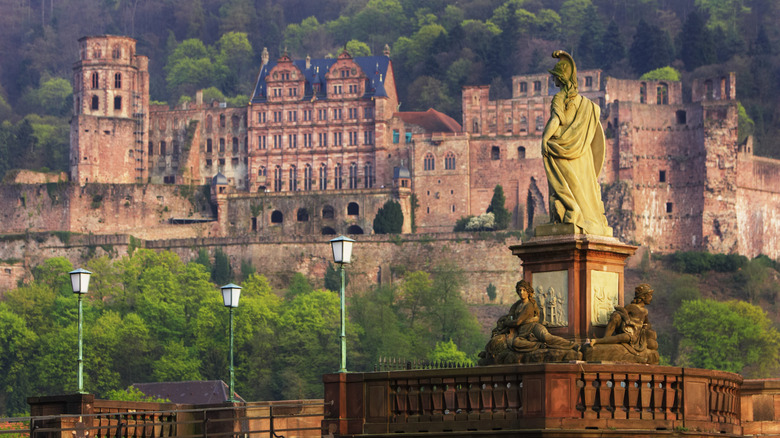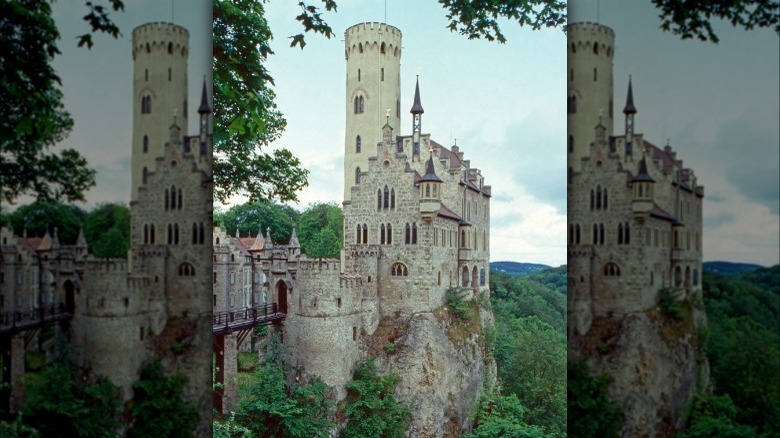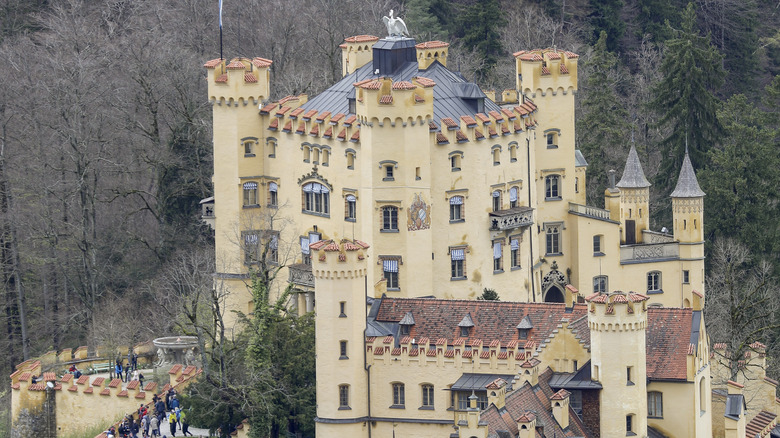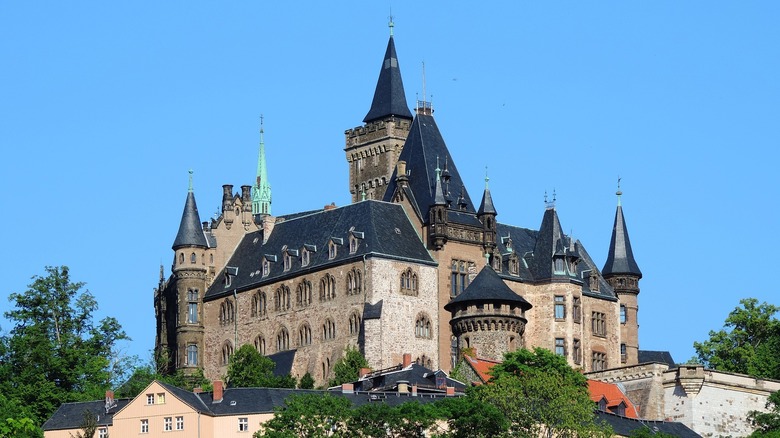Must-See Castles To Visit On Your Next Trip To Germany
Germany is a land of many things. Though some equate Germany with beer, pretzels, and oompah music, it should also elicit thoughts of schlosses – castles. Experts believe that there may be upwards of 25,000 castles throughout Germany. However, the scope of those castles' grandeur is really varied. From the petite summer palaces like Linderhoff Palace in Bavaria to the grandest of the grand like Neuschwanstein, each is exquisite in its own right.
The main reason why Germany has so many castles can be found back centuries in the country's history when the area was comprised of a series of nation-states. Castles as bases served to protect the many, many leaders and individual sovereignty throughout the region. Generally, the two kinds of castles found in Germany are either water or hill castles. Given how rugged and mountainous the country is, it should come as no surprise that the majority of the castles you can still visit are of the hill variety.
Of the tens of thousands of castles throughout Germany, a lot have fallen into disrepair and hardly resemble their former selves. There are others, however, that have been restored, rejuvenated, or kept together through the centuries that guests can still visit. These are just some of the highlights you can see in Germany.
Neuschwanstein Castle
Upon first glance, the almost mystical Neuschwanstein in the mountains looks familiar. If it gives you a magical feeling, almost like watching a Disney movie, you'd be on the right track. King Ludwig II of Bavaria (also known as The Fairytale King) built the majestic castle to be nearly as grand as he believed himself to be. Disney transformed Ludwig's home for the big screen by giving it the animated treatment for "Sleeping Beauty," though they didn't have to do much to make the castle a stunner.
King Ludwig II wanted to build the most enviable castle he could in what he believed to be the most beautiful location possible. He wanted it to outshine the home of his father, King Maximillian II. The name Neuschwanstein refers to the castle of Schwanstein that Ludgwig's father rebuilt, hence the name that translates to New Schwanstein.
Neuschwanstein has been restored in the years since The Fairytale King roamed its halls. Like other castles around the world, they weren't built for thousands of visitors strolling around the halls. So keeping the iconic castle as gilded as its former owner would want has been a struggle.
Linderhoff Palace
Of all the castles on this list, Linderhoff Palace is the smallest. But it is no less magnificent. The summer home of King Ludwig II, the grandeur of the palace was modeled after Versailles. Ludwig was wildly fascinated by Louis XIV and Marie Antoinette. Inside no photos are allowed but the gilding, artwork, and artistry of the palace will astound you. The gardens are a particularly stunning part of the property as well, you must check them out while you're there.
Ludwig's lavish palace is where he spent a lot of his time. He was known as a recluse by the rest of society – particularly the other rulers and members of his social class. Surrounding himself with velvets, gilded paintings, and beautiful things kept Ludwig in comfort even in his solitude. Tour guides at Linderhoff regale stories of Ludwig's antics for visitors including how he would eat his food as fast as possible to get out of dinner engagements with others. Why? Because if the King finishes eating before you do, you are also done eating. Dinner is over.
Going inside Linderhoff Palace is only possible through a guided tour, though anyone can access the grounds anytime the area is open. Inside visitors can see the many themed rooms dreamt up by Ludwig himself. King Ludwig II is famous for saying that he always wanted to be an "eternal mystery" to himself and others. Once you see the lengths he went to surround himself with beauty, you'll understand.
Nuremberg Castle
Considered by many to be the best example of fortifications in the Medieval era, Nuremberg Castle perfectly captures the purpose of many castles around Germany and elsewhere – protection. The reason there are so many castles in countries like Germany is that those in power needed literal walls to protect them from invaders. Some castles like Neuschwanstein are surrounded by mountains that act as protection, whereas Nuremberg built its own defenses.
The Imperial Castle Museum or Kemenate is the largest museum of cultural history in Germany and is home to one of the foremost collections of historical weapons in the country as well. In addition to the museum visitors can check out the chapel area, Sinwell Tower, the Deep Well, and the gorgeous castle gardens. Visitors can even head down the winding stairs of the Deep Well to see just how deep it really is. (Maybe don't head down if you're claustrophobic.)
Nuremberg Castle is hardly the most beautiful castle in the country, but it showcases for visitors the storied history that goes into these types of buildings. Plus areas like the Imperial Chapel, which was built in the 1200s, show how castle structures change through time. Not to mention how varied the stylistic choices are throughout the complexes.
Hohenzollern Castle
In the days of Prussia, Hohenzollern Castle housed the royal family. While members of the family still own the 19th-century building, it is no longer a royal seat. It even fell into disrepair for some time but has been restored and is a popular tourist attraction. Hohenzollern is a magnificent example of Germany's hill castles as it sits nestled among thick trees on a hillside in the Southern part of the country. Prussian royals still consider the building a part of their household even if it now serves as a museum rather than royal palace.
Many castles that are still standing today are built on top of or in name of an earlier castle. First mentions of a Hohenzollern fortress date back to the 13th century, though experts believe that the origins of this castle are much older than that. The romantic castle visitors can see today is mostly from the mid-1800s which makes sense as it was no longer needed to serve as a protective barrier by then. Now the dreamy locale could just be a home for royalty instead of a center of military protection.
Marburg Castle
Before it was considered a castle, Marburg was built in the 11th century as a fort. Famous for its role as a location during the disputes between Martin Luther and Ulrich Zwingli known as The Marburg Colloquy, the castle was cemented into history. The argument held here? It was about whether or not Christ was present in the Eucharist.
Inside Marburg is one of the best examples of a Gothic-style gathering hall in Germany, a chapel circa 1288 and many other rooms visitors can experience. One particularly fascinating area is The Prince's Hall which is decorated with art that tells the story of The Prodigal Son from The Bible. It's a fitting story for the place that sheltered Luther who was, in many ways, a Prodigal Son-like figure in the history of Christianity.
Getting up to the castle is a bit of a hike to the tune of 400 steps, but visitors can take their time seeing the other historical areas or gardens along the way. The castle is nearly a millennium old, so it makes sense that it would be harder to access.
Weesenstein Castle
An incredible example of Renaissance architecture, Weesenstein Castle is a significant landmark in Saxony. Parts of the castle structure date back to 1300 and changed purposes throughout the years. It oscillated from a defense structure to a family home until it became home to the royal family of Saxony in the 1800s. Twelve generations of the von Buenau Family even called Weesenstein Castle home until the mid-1770s.
Annual events at Weesenstein Castle celebrate the history the building represents from the Medieval Weesenstein Festival and Castle Christmas. Throughout the year the castle also hosts a variety of music and theater events as well as different exhibitions showcasing the history of the castle. Sometimes there are even exhibits nodding to the area's close proximity to the Czech Republic, formerly known as Bohemia.
Tours of the elaborate castle interiors are available in German, Czech, and English. The highlight of the interiors tour is the stunning Baroque-style chapel inside the castle which still features an exquisite pipe organ. Take a tour inside and maybe you'll get to hear the organ for yourself!
Schwerin Castle
Lovingly referred to as the Neuschwanstein of the North, Schwerin Castle appears almost as if it is floating. Situated on an island in the middle of a lake, the castle is like a swan keeping afloat. This UNESCO World Heritage Site is called one of the best examples of romantic Historicism in Europe where the dukes of Mecklenburg once lived.
The earliest construction on the castle began back in 942 though it was entirely rebuilt in 1847 by Grand Duke Friedrich Franz II because he didn't like the hodgepodge architectural elements of the former castle. He wanted it to be a homogeneous piece of brilliant architecture. There are over 650 rooms in the massive castle though visitors can see but a handful on a tour.
Since there are such lovely gardens in the lush green areas around Schwerin Castle, visiting during the spring and summer is probably the best choice. That's when the castle will shine the brightest like a floating lily on the water. You'll also get some of the best views of the regions around the castle from the top of the round tower.
Eltz Castle
Not many medieval castles are still occupied by their original owners. So the fact that the Eltz family has lived in the castle since it was built in the 1200s is pretty remarkable. It is among the oldest of the castles still standing in Germany, let alone Europe. Eltz Castle is also considered one of the best remaining examples of Medieval German architecture. The family still lives there, but a majority of the castle has been converted into a museum dedicated to its nearly 900-year history.
In addition to the dozens of castle rooms turned into museum purposes, the complex also houses both an armory and treasury. The treasury is home to one of the most prominent private collections with over 500 pieces. Both the armory and treasury are open to the public during museum visiting hours.
Just based on the sheer size of Eltz Castle and how much of it is open to the public, give yourself a few hours just to experience everything. There are also countless picturesque locations around the property to just admire the beauty.
Heidelberg Castle
Experts believe that some rendition of a castle on the grounds where Heidelberg Castle now stands dates back to around 1300. Portions of the castle built in 1400 were destroyed in the 17th and 18th centuries and were never restored. Even so, the vast structure of Heidelberg Palace (Castle) is still an incredible sight. Much like Prague Castle or other significant European castle properties, there is more to the structure than just the palace itself. Because of its architectural stat,e Heidelberg Castle is considered a ruin.
Inside the castle complex is the largest wine barrel in the world known as the Heidelberg Tun (it holds over 58,000 gallons of wine), the German Pharmacy Museum, a gourmet restaurant Scharffs Schlossweinstube, and the Heidelberg Palace Gardens among other spots. To access the grounds guests can either walk up a steep street or take a little staircase of over 300 stairs.
Don't let the stairs intimidate you. If you're able, take them slowly and enjoy the climb. As you go you can see more and more of the surrounding town. The views from the top near the castle are some of the best in the area. There's a good reason why so many folks will spend entire days meandering the castle grounds.
Lichtenstein Castle
Many other castles have inspired lookalike variations throughout history. Few were built because of inspiration from another source. The 1826 novel "Lichtenstein" actually inspired what is now known as Lichtenstein Castle. It was finished in 1842 which actually makes it one of the younger castles in Germany. Its name which translates to "shining stone" makes sense. The bright white tower coming off of the castle perched against the Swabian Alps makes it stand out.
Lichenstein Castle stands atop the foundation of the former castle that was built on the spot in 1390. That's not uncommon for castles, particularly in Germany. The architecture is known as an excellent representation of the Romantic neo-Gothic style. It was built to be the home of Count Wilhelm who then became the first Duke of Urach. The Dukes of Urach still own the castle today though now it hosts the public instead of serving as the Dukes' home.
Hohenschwangau Castle
Once again, here is a castle once inhabited by King Ludwig II. Hohenschwangau was his childhood summer home, built by his father King Maximillian II of Bavaria. Maximilian built the castle in 1832 atop the ruins of the former 12th-century castle that once resided there. This castle isn't far from Ludwig's brilliant Neuschwanstein. Hohenschwangau is almost like a miniature version of the grander castle.
Fittingly, Hohenschwangau the town is known as The Village of Royal Castles. So it's only fair that the town's romantic castle overlooks the surrounding area. Just outside the palace walls, the Castle Garden provides unparalleled views of the surrounding hillsides. The various fountains throughout the gardens align with themes throughout the castle rooms as well. These fountains represent various ideals of the royal family like Christianity, knighthood, and local identity. The gardens can be accessed with or without an entry ticket for a tour.
Guided tours are the only way to get inside Hohenschwangau Castle which takes a little less than an hour. On the premises too you can visit The Museum of Bavarian Kings to learn more about Maximillian, Ludwig, and other kings from the area's illustrious past. You can visit both Hohenschwangau and Neuschwanstein on the same day if you plan enough time in between.
Wernigerode Castle
Several iterations of a castle have been built on the same land for centuries. Parts of Wernigerode Castle date back to the 1100s, though what is still standing was mostly built in the 19th century. The dreamy, Baroque-style castle is vastly different than the other palaces in this list. Dark accents around the exterior help the building stand out from the others.
It was during the 17th century, specifically the 30 Years War, that led to the destruction of significant portions of the castle. They were rebuilt though it is part of the reason why there was no singular architectural style for it.
While other castles were torn down for not having a single architectural ideal in mind, Wernigerode celebrates its unique look. Guests can see 50 of the castle rooms on guided tours as well as the three gardens outside. The castle was even named the first German center of art and history for the 19th century. There are even events and exhibitions throughout the year dedicated to life in the castle, and the history of the times it represents.
